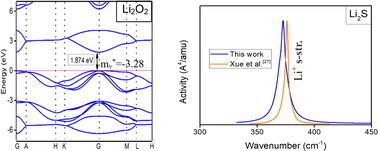Electrons and phonons of the discharge products in the lithium–oxygen and lithium–sulfur batteries from first-principles calculations†
Abstract
Batteries have become a ubiquitous daily necessity, which are popularly applied to mobile phones and electric vehicles according to their size. Improving the battery cycle life and storage is important, but unexpected discharge products still restrict the upper limit of batter performance such as Li2O2, LiO2, and Li2S. In this study, we calculated electrons and phonons presenting the basic energy states in crystal using the first-principles calculations. The Li2O2 and Li2S are almost insulating due to the wide bandgap from their electronic structure, and doped-active p-orbital may be one of the pathways to improve crystal conduction due to the tendency of the density of states. The LiO2 is metallic, and the electronic structure and phonons show that the discharge products have an ionic feature. In addition, the ionic crystal can produce a larger DC permittivity because it possesses macroscopic polarisation. For Li2O2 and Li2S, the Raman peak of the O–O bonding is strong, while the Raman peak of the S-ion is very weak. The enhanced Raman peak of the S-ion presents a possibility to prevent the shuttle effect in Li–S batteries.



 Please wait while we load your content...
Please wait while we load your content...